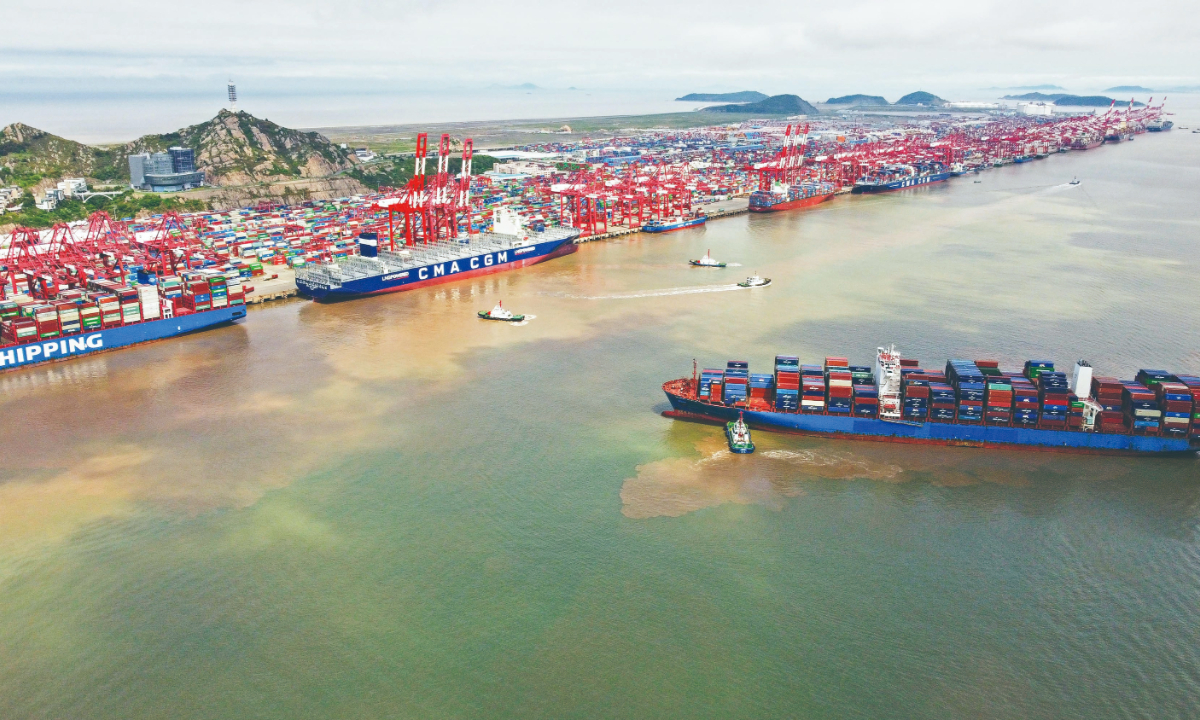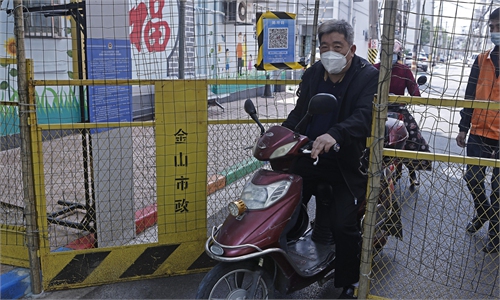Shanghai port sees 80% recovery in container throughput despite epidemic drag; port efficiency edges over US
Port congestion further eased compared with US in facilitation of business resumption

Aerial photo of Shanghai's Yangshan Port on April 24, 2022 Photo: cnsphoto
Shanghai port, the world largest container port and major transportation hub, has seen its container throughput in April recovering to 80 percent of last year's levels as the city moves toward a gradual and steady resumption of business after the epidemic situation eased with no new positive infections reported at the community level for two consecutive days as of Monday.
While the port operation is experiencing a recovery, driven by the contingency measures such as diversifying transportation tools from trucks to ships and port wide closed loop management, port efficiency has rebounded with the congestion index holding at a fairly low level even as trade orders pick up after more factories resumed production in the region.
Latest data from the Shanghai Shipping Exchange shows that in April, the average berthing time was 1.07 days, basically the same as in March, and was better than the berthing time of ships across 11 major foreign ports, including some in the US.
Despite the strict epidemic control measures needed in Shanghai and the neighboring region, the average time at the port in Shanghai was 2.12 days, a year-on-year decrease of 34.0 percent.
Moreover, Shanghai port completed a container throughput of 3.09 million TEUs in April, which was 82.4 percent of the same period last year, Li Guoping, safety director of the Ministry of Transport, said in a media interview.
The port's container throughput has continued to maintain a strong momentum in May, industry experts said.
Failed allegation
While the Shanghai port has been doing a good job in maintaining business operations amid epidemic flareups, it has been bombarded by sections of the foreign media that blame the port as a key cause of disruption for the global supply chain and port congestion, a claim that has been refuted in previous reports by the Global Times.
COVID lockdowns in China have wreaked havoc at Shanghai, the world's biggest container port, and are now causing problems at other major ports around the world, CNN reported on May 6.
"China's epidemic prevention policy would renew US West Coast port congestion," The Diplomat magazine claimed in a report published in April.
However, such critical voices have largely disappeared after more evidence suggested how resilient the Shanghai port has been even under the epidemic situation, and that port congestion has not been as it was reported.
The latest data that Elane Inc, a well-known shipping data company, sent to the Global Times shows that as of 8 am on Monday, the Shanghai port had 15 ships at anchor, and the median wait time was 40.18 hours.
By comparison, the ports of Los Angeles & Long Beach in the US had four vessels at anchor and a median wait time at anchor of 60.11 hours.
Meanwhile, the number of berthed vessels in Shanghai port was 25 compared with 24 in the US ports.
Although the number of ships in the US ports at anchor is lower than that of Shanghai port, and the number of berthing ships is basically the same, the wait time at anchor at the US port is significantly higher than that of Shanghai port.
Edge on efficiency
Experts said that the congestion of US ports has already been very serious in global terms, especially when compared with Chinese ports.
"The most congested time reached 11-12 days, and it has not been relieved much from the second half of 2020 to now," Zhao Nan from the Shanghai International Shipping Research Center told the Global Times on Monday, responding to how the ports congestion in China has not been as severe as the US.
Unlike the US, which mainly relies on a few major hub ports, China has a large number of ports, which can effectively share the pressure of Shanghai ports, Zhao said.
In addition, the situation of strikes in US ports and the shortage of labor forces during the COVID-19 pandemic are all factors that affect the efficiency of the terminal, the expert noted.
Experts said that the slow business resumption of container drivers at the US ports amid the epidemic also serves as a cause of low efficiency.
Comparatively, the situation in Shanghai is much better. Although the congestion on the road was relatively serious due to the closure, the situation at sea plays the increasingly pillar role in sustaining the transportation between factories in China and the ports.
In order to ensure the smooth operation, the Shanghai port has dispatched personnel to enter the port area in advance, with more than 20,000 people coming to work at the port under the closed loop management in late April, according to media reports.
Tu Weifeng, an official with the Shanghai Municipal Transportation Commission, said that "a large number of containers come and go via ships [instead of trucks], which helps reduce unnecessary contacts between personnel and ensures the smooth flow of the entire logistics channel."
In April, the amount of cargo delivered via ships has reached 65 percent of the total, according to Tu, and the proportion of water transfer continued to increase.
While Shanghai's epidemic situation is easing and the city is ramping up efforts to resume businesses, more factories are reopening and trade orders are being placed, which experts predicted may lead to heightened pressure at ports and even lead to certain but measurable congestions not only in Shanghai but the neighboring Ningbo and Zhoushan in East China's Zhejiang Province.
Such a trend may be further intensified in the second half of the year as foreign traders at the US and European countries start to prepare for the Christmas shopping seasons, Zhao said.

